by Patricia Herbig, photos by Kayte Deioma
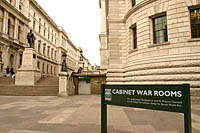 The Cabinet War Rooms was one of the very first museums I visited when we moved to London and I have been back half a dozen times since. It continues to fascinate me as the museum displays draw me into the experience. It has recently also added a new area – the Churchill Museum – to honour one of the greatest of Britain’s politician’s.
The Cabinet War Rooms was one of the very first museums I visited when we moved to London and I have been back half a dozen times since. It continues to fascinate me as the museum displays draw me into the experience. It has recently also added a new area – the Churchill Museum – to honour one of the greatest of Britain’s politician’s.
Shortly after becoming Prime Minister in May of 1940, Winston Churchill 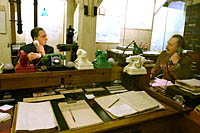 visited the War Rooms to see what preparations had been made for him and his cabinet in the event that the expected air raids on London became a reality. Upon seeing the underground Cabinet Room, he said that this was the room from which he would direct the war.
visited the War Rooms to see what preparations had been made for him and his cabinet in the event that the expected air raids on London became a reality. Upon seeing the underground Cabinet Room, he said that this was the room from which he would direct the war.
More than five years later, at the end of the war, the lights were turned off for the first time since the beginning of the war and the doors were closed; the war rooms were forgotten. In 1981, the Imperial War Museum (IWM) took over the site and converted the Cabinet War Rooms into a fascinating museum.
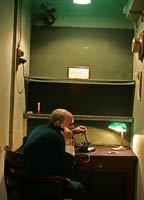 During the war years, Churchill often spent days and weeks in the underground bunker. You can see his bedroom and study just as he left it in 1945, although he only slept there a few times. There is a small cupboard, called the Transatlantic Telephone Room, with a phone that Churchill used to communicate with President Roosevelt. There is also a bedroom for his wife, Clementine Churchill, staff offices, map and communications rooms, a dining room, and a small kitchen from which it was possible to prepare the three full meals a day which Churchill required.
During the war years, Churchill often spent days and weeks in the underground bunker. You can see his bedroom and study just as he left it in 1945, although he only slept there a few times. There is a small cupboard, called the Transatlantic Telephone Room, with a phone that Churchill used to communicate with President Roosevelt. There is also a bedroom for his wife, Clementine Churchill, staff offices, map and communications rooms, a dining room, and a small kitchen from which it was possible to prepare the three full meals a day which Churchill required.
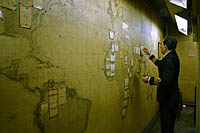 The bunker entrance of the site is still sand-bagged and leads into a new entry foyer which gives some background history. There are acoustic-guides included in the price of admission; these are strongly recommended as they give a great narrative to what you are seeing. It is possible to listen to further detail by following the directions on the audioguide.
The bunker entrance of the site is still sand-bagged and leads into a new entry foyer which gives some background history. There are acoustic-guides included in the price of admission; these are strongly recommended as they give a great narrative to what you are seeing. It is possible to listen to further detail by following the directions on the audioguide.
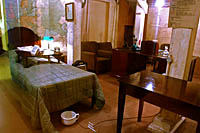 The IWM did a wonderful job of restoring the War Rooms. You get a very good sense of what it must have been like to be in those rooms during the war. Because they are underground and because people would work there for days without going outside, there are signs that tell the inhabitants what the weather is like outside.
The IWM did a wonderful job of restoring the War Rooms. You get a very good sense of what it must have been like to be in those rooms during the war. Because they are underground and because people would work there for days without going outside, there are signs that tell the inhabitants what the weather is like outside.
“We are all worms. But I do believe that I am a glow-worm.” Winston Churchill
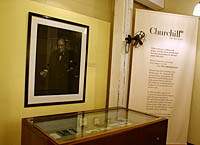 About two-thirds of the way through the Cabinet War Rooms, the IWM has created a multi-media annexe in which the Churchill collection is housed. It is divided into five colour-coded sections, each covering a separate part of Churchill’s life, starting with his childhood and moving through each major phase of his life. If you don’t know much about Churchill, it is a wonderful introduction to the man who led Britain through one of the most trying times in its history. If you do know about Churchill, you will be interested in some of the inter-active displays which feature his writing, his humour and his relationships with world political leaders and cultural icons.
About two-thirds of the way through the Cabinet War Rooms, the IWM has created a multi-media annexe in which the Churchill collection is housed. It is divided into five colour-coded sections, each covering a separate part of Churchill’s life, starting with his childhood and moving through each major phase of his life. If you don’t know much about Churchill, it is a wonderful introduction to the man who led Britain through one of the most trying times in its history. If you do know about Churchill, you will be interested in some of the inter-active displays which feature his writing, his humour and his relationships with world political leaders and cultural icons.
The Cabinet War Rooms and Churchill Museum is open daily from 9.30 – 18.00.
Address: Clive Steps, King Charles Street, London SW1A 2QA
TEL: 020-7930-6961
Admission is Ł10.00 for Adults, Ł8.00 for Senior Citizens and Free for Children under 16. Admission includes the audioguide. Additional information: www.iwm.org.uk
Public transport: Westminster or St James’s Park.
The Cabinet War Rooms and Churchill museum are included int 

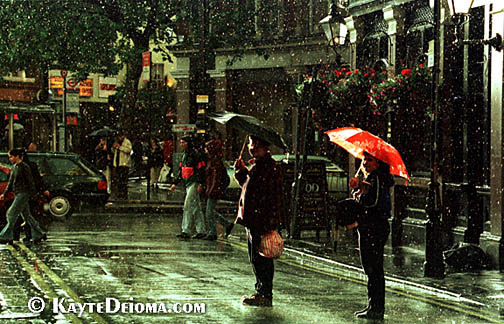
 The Cabinet War Rooms was one of the very first museums I visited when we moved to London and I have been back half a dozen times since. It continues to fascinate me as the museum displays draw me into the experience. It has recently also added a new area – the Churchill Museum – to honour one of the greatest of Britain’s politician’s.
The Cabinet War Rooms was one of the very first museums I visited when we moved to London and I have been back half a dozen times since. It continues to fascinate me as the museum displays draw me into the experience. It has recently also added a new area – the Churchill Museum – to honour one of the greatest of Britain’s politician’s. visited the War Rooms to see what preparations had been made for him and his cabinet in the event that the expected air raids on London became a reality. Upon seeing the underground Cabinet Room, he said that this was the room from which he would direct the war.
visited the War Rooms to see what preparations had been made for him and his cabinet in the event that the expected air raids on London became a reality. Upon seeing the underground Cabinet Room, he said that this was the room from which he would direct the war. During the war years, Churchill often spent days and weeks in the underground bunker. You can see his bedroom and study just as he left it in 1945, although he only slept there a few times. There is a small cupboard, called the Transatlantic Telephone Room, with a phone that Churchill used to communicate with President Roosevelt. There is also a bedroom for his wife, Clementine Churchill, staff offices, map and communications rooms, a dining room, and a small kitchen from which it was possible to prepare the three full meals a day which Churchill required.
During the war years, Churchill often spent days and weeks in the underground bunker. You can see his bedroom and study just as he left it in 1945, although he only slept there a few times. There is a small cupboard, called the Transatlantic Telephone Room, with a phone that Churchill used to communicate with President Roosevelt. There is also a bedroom for his wife, Clementine Churchill, staff offices, map and communications rooms, a dining room, and a small kitchen from which it was possible to prepare the three full meals a day which Churchill required. The bunker entrance of the site is still sand-bagged and leads into a new entry foyer which gives some background history. There are acoustic-guides included in the price of admission; these are strongly recommended as they give a great narrative to what you are seeing. It is possible to listen to further detail by following the directions on the audioguide.
The bunker entrance of the site is still sand-bagged and leads into a new entry foyer which gives some background history. There are acoustic-guides included in the price of admission; these are strongly recommended as they give a great narrative to what you are seeing. It is possible to listen to further detail by following the directions on the audioguide. The IWM did a wonderful job of restoring the War Rooms. You get a very good sense of what it must have been like to be in those rooms during the war. Because they are underground and because people would work there for days without going outside, there are signs that tell the inhabitants what the weather is like outside.
The IWM did a wonderful job of restoring the War Rooms. You get a very good sense of what it must have been like to be in those rooms during the war. Because they are underground and because people would work there for days without going outside, there are signs that tell the inhabitants what the weather is like outside. About two-thirds of the way through the Cabinet War Rooms, the IWM has created a multi-media annexe in which the Churchill collection is housed. It is divided into five colour-coded sections, each covering a separate part of Churchill’s life, starting with his childhood and moving through each major phase of his life. If you don’t know much about Churchill, it is a wonderful introduction to the man who led Britain through one of the most trying times in its history. If you do know about Churchill, you will be interested in some of the inter-active displays which feature his writing, his humour and his relationships with world political leaders and cultural icons.
About two-thirds of the way through the Cabinet War Rooms, the IWM has created a multi-media annexe in which the Churchill collection is housed. It is divided into five colour-coded sections, each covering a separate part of Churchill’s life, starting with his childhood and moving through each major phase of his life. If you don’t know much about Churchill, it is a wonderful introduction to the man who led Britain through one of the most trying times in its history. If you do know about Churchill, you will be interested in some of the inter-active displays which feature his writing, his humour and his relationships with world political leaders and cultural icons.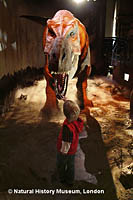 A couple of years ago, the Government decided that everyone should be able to take advantage of the wonderful museums that London has to offer; it made them all free. As a result, they are now more crowded, but as tourists, you won’t have the added expense of entry fees. My family particularly enjoys the Natural History Museum. As with all large museums, it’s best to pick a couple exhibits to see, other wise everyone is overwhelmed and the kids especially have a bad time.
A couple of years ago, the Government decided that everyone should be able to take advantage of the wonderful museums that London has to offer; it made them all free. As a result, they are now more crowded, but as tourists, you won’t have the added expense of entry fees. My family particularly enjoys the Natural History Museum. As with all large museums, it’s best to pick a couple exhibits to see, other wise everyone is overwhelmed and the kids especially have a bad time.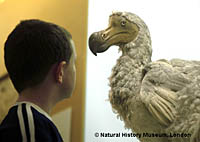 The Life Sciences section has huge fossils and dinosaur skeletons and a special exhibit in which they have a life-sized T-Rex which moves and roars. It’s a bit scary for very little children, so be warned. Other treats are rare stuffed birds, including a dodo. There are wonderful small and large fossils found along the southwest coast (named the Jurassic Coast) of England. The exhibit on Creepy Crawlies attracts kids of all ages back again and again.
The Life Sciences section has huge fossils and dinosaur skeletons and a special exhibit in which they have a life-sized T-Rex which moves and roars. It’s a bit scary for very little children, so be warned. Other treats are rare stuffed birds, including a dodo. There are wonderful small and large fossils found along the southwest coast (named the Jurassic Coast) of England. The exhibit on Creepy Crawlies attracts kids of all ages back again and again.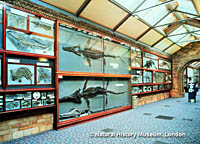 Our favorites are probably the fossils and dinosaurs and the area with the dioramas of prehistoric and modern animals. The huge fossils of prehistoric sea animals displayed on the walls are truly impressive. The smaller ones in the cases inspired us to go to Dorset and the Jurassic coast to look for more -which we indeed found!
Our favorites are probably the fossils and dinosaurs and the area with the dioramas of prehistoric and modern animals. The huge fossils of prehistoric sea animals displayed on the walls are truly impressive. The smaller ones in the cases inspired us to go to Dorset and the Jurassic coast to look for more -which we indeed found!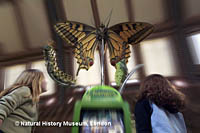 The Earth Sciences exhibits are reached up a long escalator in the main entry hall. You enter through a gallery of rare crystals in cases which are lit with black light to enhance the color
The Earth Sciences exhibits are reached up a long escalator in the main entry hall. You enter through a gallery of rare crystals in cases which are lit with black light to enhance the color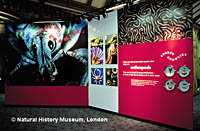 There is also a room fitted out as a small grocery shop in Kobe. Every couple of minutes, there is a recreation of what it would have been like to have been in the shop at the moment of the earthquake – initial tremours, then stronger and stronger shaking.
There is also a room fitted out as a small grocery shop in Kobe. Every couple of minutes, there is a recreation of what it would have been like to have been in the shop at the moment of the earthquake – initial tremours, then stronger and stronger shaking.